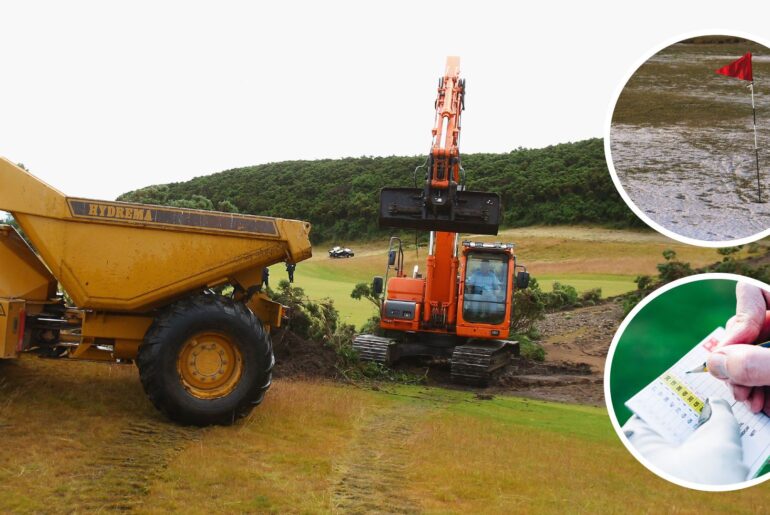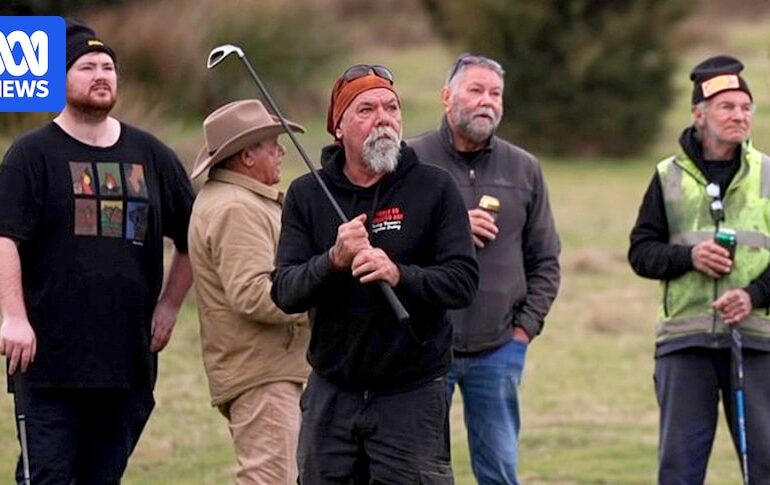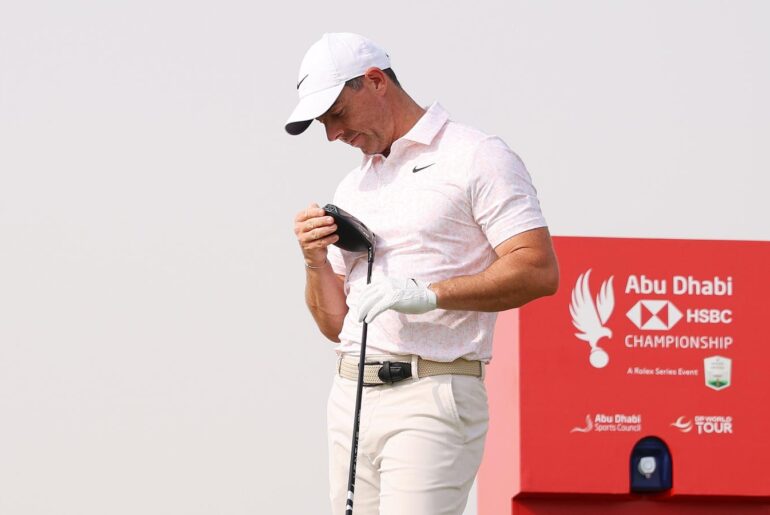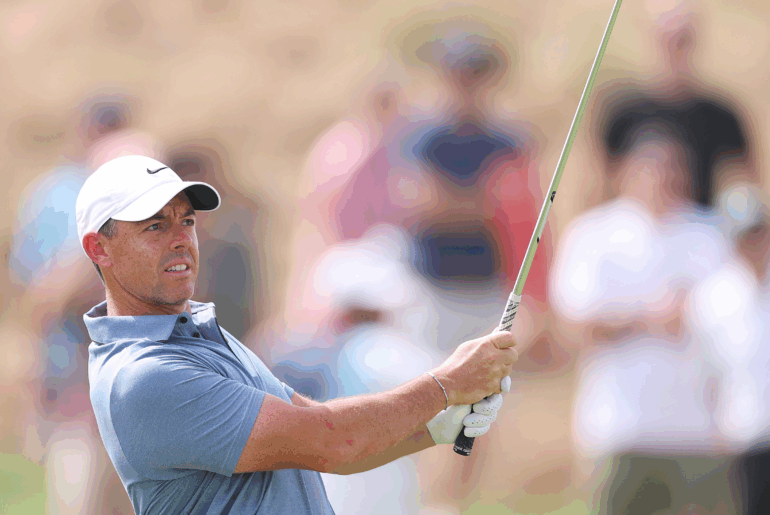Improving your proximity to the hole and finding more greens in regulation is one of the surest ways to shoot lower scores. But which golf ball will actually help you do that?
The best golf ball for you is the one that helps you hit more greens, more often. If your approach shots keep coming up short or missing the target, it’s not all down to your swing. Your golf ball can make a huge difference.
Our latest robot test shows that switching to one of three premium golf balls could transform your approach play performance.
How we tested the golf balls
To find out which models are best for approach play, we tested 62 different golf balls using a $100,000 robot to hit a 7-iron at 80mph (club golfer average speed). This machine delivers the same strike every time, so the only variable in our test was the ball itself.
What makes a golf ball good for approach play?
When looking to improve your proximity to the hole, there are a few key factors to consider:
Descent angle: Descent angle is the angle at which the ball lands. The steeper the descent angle, the smaller and shorter the first bounce.
Spin: Spin helps the ball ‘grab’ the green to stop quicker. Spin isn’t as important as descent angle because, as long as the first bounce is steep enough, the ball will still come to a rest on the green – it might just roll out a little bit farther if the spin is lower.
Carry distance consistency: Being able to trust your ball to carry a certain distance consistently reduces the chance of flying the green or coming up short.
Now that’s cleared up, let’s get into the results.
Which golf balls land with the steepest descent angle?Golf ballDescent angle (°)Descent angle rankWilson Staff Model X45.41stSrixon Z-Star Diamond45.32ndMizuno RB 56645.33rdSrixon Z-Star45.34thCallaway Chrome Tour X45.35thTaylorMade TP545.36thWilson Staff Model45.27thTitleist Tour Soft45.28thPXG Xtreme Tour X45.29thBridgestone Tour B XS45.210thSrixon Z-Star XV45.211thTaylorMade TP5x45.212th
The Wilson Staff Model X lands with the steepest descent angle, and out of all 62 golf balls we tested, it’s the only model to land with a 45.4° descent angle. The rest of the top 12 all land with a descent angle of 45.3° and 45.2° – only 0.22° separates first and 12th.
Which golf balls generate the most backspin?Golf ballBackspin (rpm)Backspin rankCallaway Chrome Tour X5,2421stBridgestone Tour B XS5,1702ndSrixon Z-Star Diamond5,1493rdMizuno RB 5664,9474thSrixon Z-Star4,9375thSrixon Z-Star XV4,9306thKirkland Signature V3.04,8617thTaylorMade TP54,8238thPXG Xtreme Tour X4,8209thBridgestone Tour B RXS4,81310thVice Pro Plus4,80711th
Only the 11 golf balls above generate over 4,800rpm. The highest-spinning model is the Callaway Chrome Tour X. Over 400rpm separates first from 11th, so you can trust all 11 balls to stop quickly when firing at pins.
Which golf balls deliver the best carry distance consistency?Golf ballCarry distance consistency rankVice Pro1stSrixon Q-Star Tour2ndSrixon Z-Star XV3rdSrixon Z-Star Diamond4thSrixon Z-Star5thBridgestone Tour B XS6thWilson Triad7thTitleist Pro V1x8thCallaway Chrome Tour X9thBridgestone Tour B RXS10th
The best golf ball for carry distance consistency is the Vice Pro. Four Srixon models occupy the rest of the placings in the top five, including all three Z-Star golf balls.
The most dominant golf balls for attacking pins
Taking each golf ball’s descent angle, backspin, and carry distance consistency into consideration, we’ve found the models we think work at the highest level for approach play performance.
With an iron in hand, any of the three golf balls within the Srixon Z-Star range will give you a greater chance of not only finding the green, but also hitting it closer to the hole. Despite not topping the rankings for any individual metric, their consistency across all three key criteria made them the standout performers.
Golf ballBackspin (rpm)Backspin rankDescent angle (°)Descent angle rankCarry distance consistency rankSrixon Z-Star Diamond5,1493rd45.32nd4thSrixon Z-Star4,9375th45.34th5thSrixon Z-Star XV4,9306th45.211th3rd
The Srixon Z-Star Diamond is the best golf ball for approach play performance, excelling in every important aspect of iron play and ranking in the top five for backspin, descent angle, and carry distance consistency among all 62 golf balls tested.
The most dominant 3-piece Tour-level golf ball
Best overall golf ball for approach play
Robot test verdict
The Srixon Z-Star Diamond is one of the best high-spin golf balls. This golf ball was initially designed for Brooks Koepka, but it’s become more popular among other Srixon staffers and amateur golfers. Based on our 2025 robot test results, it’s clear to see why!
The Z-Star Diamond won an award in every category, barring one (off-the-tee performance), but where it did rank, it took the top spot. Let’s have a quick run through the Z-Star Diamond’s awards: gold medal for tee to green performance at 114mph, 93mph, and 78mph, gold medal for approach play, and gold medal for short-game performance.
Around the greens, the Z-Star Diamond is the best three-piece Tour-level golf ball you can play, and the second-best golf ball of all 62 tested, generating 6,137rpm at the 40-yard pitch shot.
However, it’s unlikely you’ll miss the green in the first place! The Z-Star Diamond is the best golf ball for firing at pins. This golf ball ranks second for descent angle (45.3°), fourth for carry distance consistency, and third for backspin (5,149rpm – one of only three golf balls with over 5,000rpm). This is a recipe for success when you’re attacking pins.
The Z-Star Diamond is a consistent golf ball off the tee at all three driver swing speeds. So, whether you swing like Koepka or not, this golf ball will deliver strong numbers for your swing speed. The Z-Star Diamond is above the test average for ball speed and carry distance at all three driver swing speeds.
This golf ball cleaned up in the three-piece Tour-level category! The Z-Star Diamond has to be on your mind if you’re looking for a new golf ball.
On-course verdict
The Srixon Z-Star Diamond delivers the optimal performance out of the three golf balls in the 2025 Z-Star range.
The Z-Star Diamond is brilliant if you’re looking for one of the best high-spin golf balls because it’s very easy to generate spin with this model. That being said, it’s definitely lower-spinning off the tee than the previous generation.
I’ve tested a heap of outstanding Tour-level golf balls over the past couple of years, but I don’t think any have impressed me as much as the Z-Star Diamond on approach shots.
If you think a golf ball that travels far and spins high sounds right for your game, then you have to try the Z-Star Diamond, regardless of your ability.
I absolutely love how this golf ball feels off every club face in my bag. I wouldn’t necessarily say it’s particularly firmer than the Z-Star or Z-Star XV, but I think the feedback is much stronger. Thanks to the solid feedback, the response is very satisfying on well-struck shots, but not so much when the contact isn’t as good. However, I think that’s what makes a good golf ball.
Of all the golf balls I’ve played with over the past couple of seasons, this is without a doubt the best-performing golf ball from tee to green.
The Z-Star Diamond performs optimally in every area, which makes it extremely difficult to criticize. It feels great, feedback is fantastic, and performance is extraordinary.
I don’t know what more a golf ball can offer!
Read our full Srixon Z-Star Diamond golf ball review.
Pros & Cons Specs Features
Pros Amazing control from tee to greenHigh spinning in the iron and short gameFantastic feedback and response Cons High-spinning nature does slightly hinder distance Carry distance (yds) Driver 114mph – 270.7 | Driver 93mph – 207.8 | Driver 78mph – 161 | 7-iron – 153.1 Ball speed (mph) Driver 114mph – 163.6 | Driver 93mph – 133.8 | Driver 78mph – 113.1 | 7-iron – 108.7 Backspin (rpm) Driver 114mph – 2,988 | Driver 93mph – 2,838 | Driver 78mph – 2,719 | 7-iron – 5,149 | Pitch – 6,137 Launch angle (°) Driver 114mph – 11.2 | Driver 93mph – 12.5 | Driver 78mph – 13.6 | 7-iron – 20.5 | Pitch – 30 Descent angle (°) Driver 114mph – 39.4 | Driver 93mph – 32.6 | Driver 78mph – 28.1 | 7-iron – 45.3 | Pitch – 35.1 Peak height (yds) Driver 114mph – 34.5 | Driver 93mph – 22.4 | Driver 78mph – 15.7 | 7-iron – 29.3 | Pitch – 6.5 Compression (psi) 106 Speed dimple patternThin premium Biomass coverSpin skin+ coatingFastlayer DG core 2.0338 dimples3-Piece constructionAvailable in white and yellow
Being Srixon’s highest-spinning premium golf ball, it’s perhaps unsurprising to see the Z-Star Diamond come out on top for approach play performance, but we definitely didn’t expect all three models to be at the top of the rankings.
Closely following the Z-Star Diamond is the Srixon Z-Star, which is the lowest-compression model in the Z-Star family and the softest-feeling. The Z-Star is the only other golf ball – alongside the Z-Star Diamond – to rank in the top five for backspin, descent angle, and carry distance consistency out of all 62 golf balls tested.
The Z-Star is lower-spinning than the Z-Star Diamond by over 200rpm, but with the same descent angle, this ball is going to stop quickly on the greens, allowing you to fire at the pins, with minimal roll out.
Silver medal for tee to green performance at 78mph and approach play performance
Best low-compression premium golf ball for approach play
Robot test verdict
Srixon’s Z-Star line-up has blown the three-piece Tour-level competition away. Granted, much of that is thanks to the Z-Star Diamond, but the Srixon Z-Star also contributed with a silver medal for tee-to-green performance at 78mph and approach-play performance.
The Z-Star is right there with the Z-Star Diamond for approach play performance, but it sadly just misses out on the top spot and has to settle for second-best out of all 62 golf balls tested. The Z-Star ranks fourth for descent angle (45.3°), fifth for carry distance consistency, and fifth for backspin (4,937rpm).
Being a lower-spinning golf ball than the Z-Star Diamond, it’s hardly surprising to see the Z-Star rank lower in short-game performance. The Z-Star is the sixth-highest spinning three-piece Tour-level golf ball at the 40-yard pitch shot – firmly above the test average with 5,926rpm.
With a silver medal for tee to green performance at 78mph, the Z-Star performs best at slower swing speeds, ranking fifth overall. At more moderate and quicker swing speeds, the Z-Star isn’t as strong off the tee, and that’s perhaps why it’s not as popular on Tour as Z-Star Diamond or Z-Star XV.
That being said, Z-Star is a golf ball for slower swing speed players to consider, especially if you want a golf ball you can trust when playing from the fairway.
On-course verdict
The Z-Star is my least-favored golf ball in Srixon’s Z-Star range, but that’s not to say it will be for everyone. For my game, it doesn’t perform as well from tee to green as the Diamond or XV.
This is noticeably softer than the Diamond and XV, which I think makes it less responsive, and it dampens the feedback.
On the whole, all three Z-Star golf balls are very closely matched, but on the course, I can definitely tell this golf ball isn’t right for me off the tee because it doesn’t spin enough. For some golfers, that will be a plus, but for my game, I require a higher-spinning model.
The Z-Star has the lowest compression rating of the three models in Srixon’s Z-Star range, and for that reason, it works best for golfers with slower swing speeds because it’s easier to eke out its performance. If you swing the club too quickly, you go beyond the threshold of optimal performance.
Pros & Cons Specs Features
Pros Amazing tee to green performancePremium option for golfers with slower swing speedsVery soft feel Cons Doesn’t perform as well at quicker swing speeds Carry distance (yds) Driver 114mph – 269.4 | Driver 93mph – 206.6 | Driver 78mph – 161.1 | 7-iron – 154.1 Ball speed (mph) Driver 114mph – 162.7 | Driver 93mph – 133.1 | Driver 78mph – 113.1 | 7-iron – 108.7 Backspin (rpm) Driver 114mph – 2,900 | Driver 93mph – 2,859 | Driver 78mph – 2,693 | 7-iron – 4,937 | Pitch – 5,926 Launch angle (°) Driver 114mph – 11.1 | Driver 93mph – 12.6 | Driver 78mph – 13.7 | 7-iron – 20.8 | Pitch – 30.6 Descent angle (°) Driver 114mph – 38.5 | Driver 93mph – 32.8 | Driver 78mph – 28.1 | 7-iron – 45.3 | Pitch – 35.9 Peak height (yds) Driver 114mph – 33.3 | Driver 93mph – 22.4 | Driver 78mph – 15.8 | 7-iron – 29.5 | Pitch – 6.9 Compression (psi) 92 Speed dimple patternThin premium Biomass coverSpin skin+ coatingFastlayer DG core 2.0338 dimples3-Piece constructionAvailable in white and yellowAn alternative model is the Divide
Rounding out the dominant performance in approach play by the Z-Star range is the Srixon Z-Star XV. This is perhaps the most surprising model to feature among the best golf balls for approach play performance because it is the distance-oriented Z-Star model. It is the longest of the three Z-Star golf balls. However, the Z-Star XV is also high-spinning (6th overall) and delivers the best carry-distance consistency of the three models.
The Z-Star XV offers a more penetrating ball flight than the Z-Star and Z-Star Diamond, which suggests why its descent angle is lower – albeit by only 0.1°.
Silver medal for tee to green performance at 114mph
Best feeling Srixon golf ball for approach play

Rrp: £40.08
Price: £38.99
Robot test verdict
The Srixon Z-Star XV is the distance-oriented model in Srixon’s Z-Star line-up, and it’s the ball of choice for 2019 Champion Golfer Shane Lowry, 2021 Masters Champion Hideki Matsuyama, and Austria’s only PGA Tour winner, Sepp Straka.
Despite being the supposed longest golf ball in the Z-Star range, the Z-Star XV isn’t as long as the Z-Star Diamond at any of the three driver swing speeds tested. That being said, at 114mph, it’s very close.
Add in the impressive approach play performance, and there’s no surprise this golf ball won the silver medal for tee to green performance at the quick swing speed. The Z-Star XV ranked third for approach play in the entire test – sadly, behind the Z-Star and Z-Star Diamond.
The Z-Star XV is said to be the lowest-spinning Z-Star model, but even around the greens, it’s slightly ahead of the Z-Star (albeit by 22rpm). The Z-Star XV might sound as though it’s living in the shadow of the Z-Star and Z-Star Diamond. However, there’s clearly a reason why it’s so popular on Tour.
As well as being the second-best three-piece Tour-level golf ball for tee to green performance at 114mph, the Z-Star XV also won bronze for tee to green performance at 78mph, and bronze for approach play.
There’s a lot to love about the Z-Star XV, and like the other two models in the Z-Star line-up, this is a brilliant golf ball for attacking pins with. It’s incredibly versatile across all three swing speeds, and it puts itself in the conversation with the Z-Star and Z-Star Diamond.
On-course verdict
The Z-Star XV is incredibly popular on Tour, and it’s easy to see why after just a couple of holes. This golf ball delivers excellent performance across the board, with an emphasis on distance.
I can’t say for sure whether I noticed considerable distance gains over other golf balls in Srixon’s Z-Star range, but it’s definitely competitive.
The Z-Star XV is designed to be the lowest-spinning golf ball in the Z-Star line-up, but it’s far from low-spinning. On the course, this ball stops very quickly when approaching and playing around greens – as you’d expect for a Tour-level golf ball.
I find the XV to have a slightly softer feel than the Z-Star Diamond, and for that reason, I don’t think it’s as responsive, but the feeling itself is enjoyable.
As I’ve already mentioned, this is a very popular Srixon golf ball on Tour, and it doesn’t take long to realize why when you play with it on the golf course.
Pros & Cons Specs Features
Pros Impressive tee to green performanceGood Tour representationGreat feel Cons Lower-spinning than the Z-Star Diamond Carry distance (yds) Driver 114mph – 270.6 | Driver 93mph – 207.7 | Driver 78mph – 160.8 | 7-iron – 154.2 Ball speed (mph) Driver 114mph – 163.4 | Driver 93mph – 133.6 | Driver 78mph – 113.2 | 7-iron – 108.7 Backspin (rpm) Driver 114mph – 2,936 | Driver 93mph – 2,857 | Driver 78mph – 2,654 | 7-iron – 4,930 | Pitch – 5,948 Launch angle (°) Driver 114mph – 11.2 | Driver 93mph – 12.6 | Driver 78mph – 13.8 | 7-iron – 20.7 | Pitch – 30.3 Descent angle (°) Driver 114mph – 39 | Driver 93mph – 32.9 | Driver 78mph – 27.6 | 7-iron – 45.2 | Pitch – 35.6 Peak height (yds) Driver 114mph – 34 | Driver 93mph – 22.6 | Driver 78mph – 15.5 | 7-iron – 29.3 | Pitch – 6.7 Compression (psi) 112 Speed dimple patternThin premium Biomass coverSpin skin+ coatingFastlayer DG core 2.0338 dimples3-Piece constructionAvailable in white and yellow Why are all the Srixon Z-Star golf balls good for approach play performance?
You’re now probably wondering why all three Z-Star golf balls are so strong when it comes to iron play. Allow me to explain…
All three models sport the same technology from the urethane Biomass cover, derived from Biopolyol extracted from corn, to the Spin Skin+ coating, FastLayer DG Core 2.0, and 338 Speed Dimple Pattern.
Given that all three Z-star balls feature the technology, it makes sense that they all performed well (and similarly) in our 2025 robot test.
Which Srixon Z-Star model should you play?
After learning that all three Z-Star golf balls feature the same technology, you might be wondering, “How do I know which model is right for me?”, and that’s completely understandable.
The Z-Star Diamond is used by Brooks Koepka, JJ Spaun, and Hannah Green, among others. After testing on a robot and on course, we’ve found this model to be the highest-spinning and highest-flying of the three Z-Star golf balls.
If you’re looking for something with a firmer feel, higher compression, and lower spin, then it’s the Z-Star XV you want to consider. This model has the highest Tour approval rating of the three premium Srixon balls, used by Shane Lowry, Hideki Matsuyama, and Sepp Straka.
The Z-Star should be at the top of your list if you want the softest, lowest-compression model in this range. The Z-Star is going to fly slightly lower than the Z-Star Diamond and Z-Star XV, and it’s used by LPGA Tour players Miyu Yamashita and Nasa Hataoka.







